High Emotions for “One Belgium” in the World Cup(No.57)
Almost three weeks have passed since the kick-off of the football World Cup in Brazil and the first league, which was divided into eight groups, has come to an end. In group H Belgium competed against Algeria, Russia and South Korea, winning all three matches, and advanced to the eighth-finals (the match against the USA is tonight!). It is a refreshing surprise that a football team on “national level” is formed in Belgium, in a country which is divided north and south politically as well as economically under the federal system, and to see the whole nation supporting for Belgium. On the nights when Belgium won all around the city excitement could be heard – cars flying the Belgian flag kept sounding their horns. On the other side, in contrast to this, our Japanese team played against Colombia, Greece, and Ivory Coast in group C, and left the first league with a tie and two defeats. The Japanese football fans, who were hoping for Japan to reach the eighth-finals, were deeply disappointed. Nevertheless, I was surprised, when watching the television, that King Philippe and Her Majesty visited Brazil to spectate the games of Belgium in the stadium, and when the match was over they personally congratulated the players of the Belgian team. Although both countries differ, such an occurrence would be unimaginable in the case of the Japanese imperial family.
<A Reception for the Second Japanese Self-Defence Forces Day Commemoration>
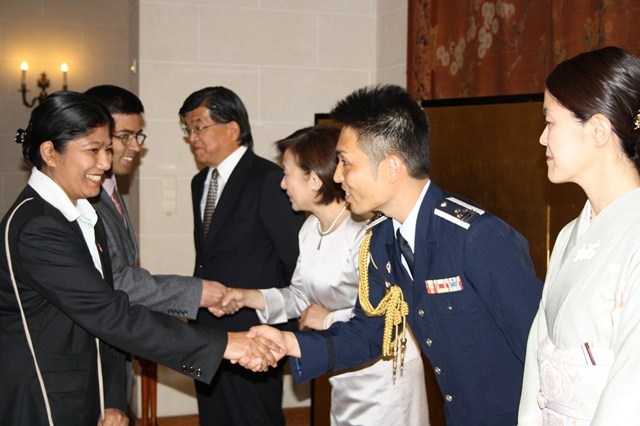 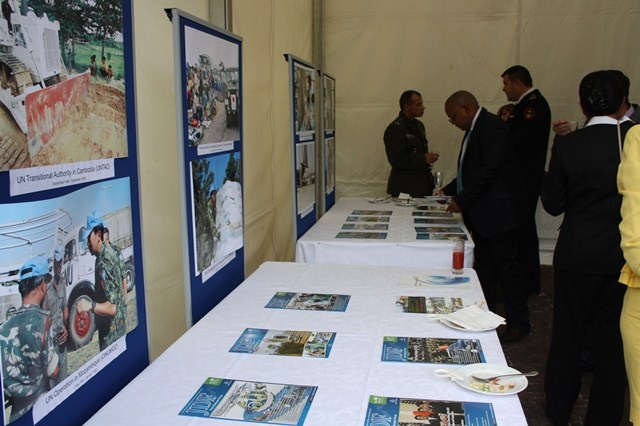 The previous week, a reception for the commemoration of the Japanese Self-Defence Forces Day was held at the ambassador’s residence. It was the second time for me to host this reception in Brussels. This time the reception was catered to the more than 180 guests from the Belgian government and army, as well as NATO-affiliated members and diplomats. Fortuned with nice weather, I also opened the garden to the guests, and it became a pleasant garden party sort of event. Just as the previous year, besides all sorts of Japanese food that were provided, such as sushi and tempura, the Japanese sake and Japanese wine tasting corner that was set up was highly popular.yomoyama_057_jieitai3 The previous week, a reception for the commemoration of the Japanese Self-Defence Forces Day was held at the ambassador’s residence. It was the second time for me to host this reception in Brussels. This time the reception was catered to the more than 180 guests from the Belgian government and army, as well as NATO-affiliated members and diplomats. Fortuned with nice weather, I also opened the garden to the guests, and it became a pleasant garden party sort of event. Just as the previous year, besides all sorts of Japanese food that were provided, such as sushi and tempura, the Japanese sake and Japanese wine tasting corner that was set up was highly popular.yomoyama_057_jieitai3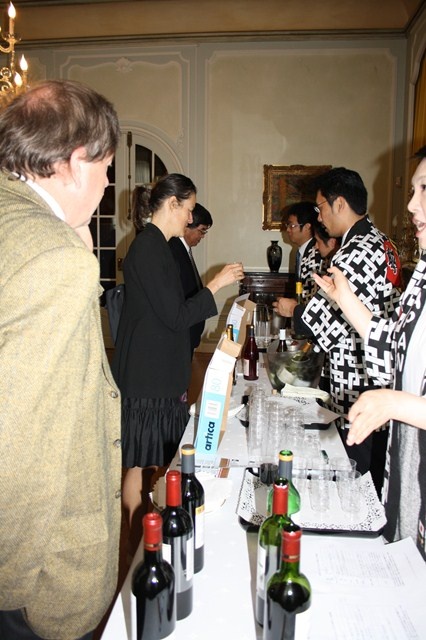 In addition, as a test, I decided to display a large photo panel introducing the past activities of the Japanese Self-Defence Force’s participation in the United Nations Peacekeeping Operations and Japan’s Emergency Relief Team, and to show an English-narrated DVD introducing the Japanese Self-Defence Force on a television in the main hall. Our Self-Defence Force started out in 1954, marking this year its 60th anniversary. In the midst of the heated discussion in Japan on the political level surrounding the right to collective self-defence and collective security, I think the interest in Japan, as well as abroad, towards the international and domestic security co-operations of the Japanese Self-Defence Force is growing. As an ambassador abroad, it was of significance to hold such a reception as this one for the many invited guests of the country I’m assigned to, and to introduce the activities of the Japanese Self-Defence Force. In addition, as a test, I decided to display a large photo panel introducing the past activities of the Japanese Self-Defence Force’s participation in the United Nations Peacekeeping Operations and Japan’s Emergency Relief Team, and to show an English-narrated DVD introducing the Japanese Self-Defence Force on a television in the main hall. Our Self-Defence Force started out in 1954, marking this year its 60th anniversary. In the midst of the heated discussion in Japan on the political level surrounding the right to collective self-defence and collective security, I think the interest in Japan, as well as abroad, towards the international and domestic security co-operations of the Japanese Self-Defence Force is growing. As an ambassador abroad, it was of significance to hold such a reception as this one for the many invited guests of the country I’m assigned to, and to introduce the activities of the Japanese Self-Defence Force.
<The Unknown World Heritage Site in Antwerp: the Plantin-Moretus Museum>
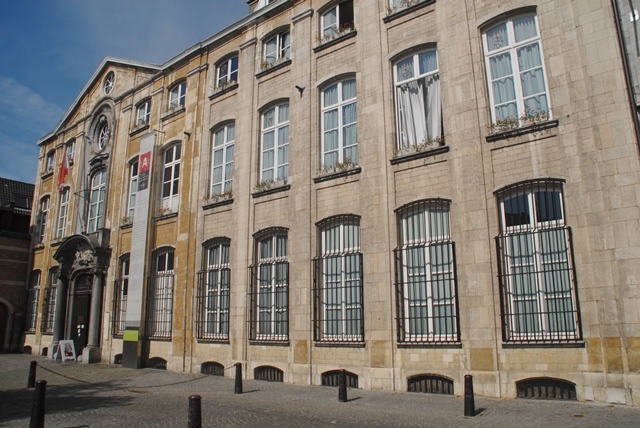 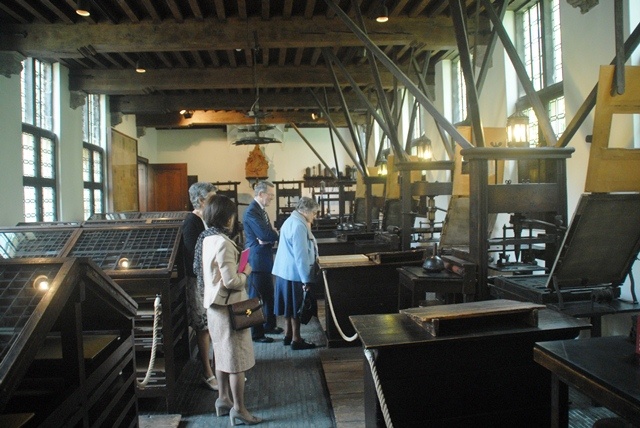 If you bring up touristic spots, representative of Antwerp, many would be of the opinion that these would be the cathedral or the Rubens House. But, there is a must-see spot, according to the Michelin Green Guide, who awarded it a three-star rating, and was appointed a UNESCO world heritage site in 2005—namely, the Plantin-Moretus Museum. Unfortunately, there is little interest from Japanese travel agencies, and as such, there are rarely any Japanese tourists who go visit the museum. In the heart of the city, the museum is culturally highly appraised and is worth having a look at for those who take an interest in history.yomoyama_057_museum3 If you bring up touristic spots, representative of Antwerp, many would be of the opinion that these would be the cathedral or the Rubens House. But, there is a must-see spot, according to the Michelin Green Guide, who awarded it a three-star rating, and was appointed a UNESCO world heritage site in 2005—namely, the Plantin-Moretus Museum. Unfortunately, there is little interest from Japanese travel agencies, and as such, there are rarely any Japanese tourists who go visit the museum. In the heart of the city, the museum is culturally highly appraised and is worth having a look at for those who take an interest in history.yomoyama_057_museum3 The story of the invention of letterpress printing technology (a printing technology using metal typefaces) by Gutenberg in the 15th century is widely known and introduced in textbooks in schools, but it is little known that this technology only became widespread since the 16th century, and that one of the centres from where it dispersed worldwide, was Antwerp. Gutenberg printed large quantities of the Old and New Testament in Latin—it caused great influence in later religious reforms, but it is only when many versions of the Bible were printed in several different languages, including Dutch and when literary works and newspapers also began being printed in huge numbers, that the path for Europe towards the modern age was opened. This is because in the latter part of the 16th century, Officina Plantiniana, the press of Plantin, made Antwerp at the centre of printing. The previous day I got acquainted with a descendant of the founder of the Officina Plantiniana, and I was personally given a guide of the Plantin-Moretus Museum (currently under municipal ownership of the city of Antwerp). The museum holds more than 20,000 books printed between the 17th and 18th century, and also has several copies of early edition Bibles on a special display. The studio displaying the old letterpress machine was also being preserved, and I was taken aback by the exquisite metal typefaces. The printing museum set up by a Japanese printing company, Toppan Printing (located in the basement floor of the Toppan Hall in Koishikawa, Tokyo), has an early printing machine from Antwerp on display, which apparently is a replicate made in co-operation with Plantin-Moretus. It made me glad to find out a connection between Japan and Belgium in such a place. The story of the invention of letterpress printing technology (a printing technology using metal typefaces) by Gutenberg in the 15th century is widely known and introduced in textbooks in schools, but it is little known that this technology only became widespread since the 16th century, and that one of the centres from where it dispersed worldwide, was Antwerp. Gutenberg printed large quantities of the Old and New Testament in Latin—it caused great influence in later religious reforms, but it is only when many versions of the Bible were printed in several different languages, including Dutch and when literary works and newspapers also began being printed in huge numbers, that the path for Europe towards the modern age was opened. This is because in the latter part of the 16th century, Officina Plantiniana, the press of Plantin, made Antwerp at the centre of printing. The previous day I got acquainted with a descendant of the founder of the Officina Plantiniana, and I was personally given a guide of the Plantin-Moretus Museum (currently under municipal ownership of the city of Antwerp). The museum holds more than 20,000 books printed between the 17th and 18th century, and also has several copies of early edition Bibles on a special display. The studio displaying the old letterpress machine was also being preserved, and I was taken aback by the exquisite metal typefaces. The printing museum set up by a Japanese printing company, Toppan Printing (located in the basement floor of the Toppan Hall in Koishikawa, Tokyo), has an early printing machine from Antwerp on display, which apparently is a replicate made in co-operation with Plantin-Moretus. It made me glad to find out a connection between Japan and Belgium in such a place.
<International Carillon Competition>
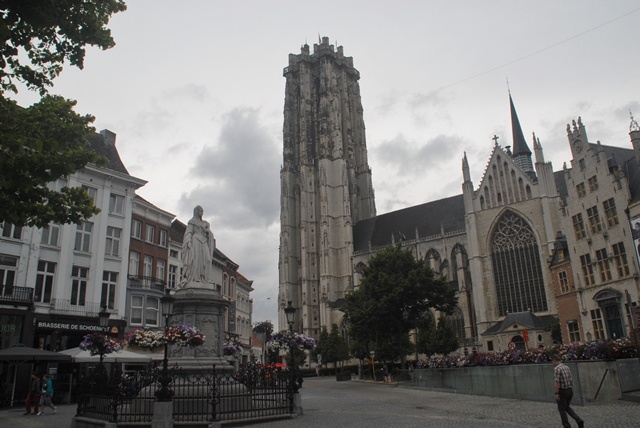 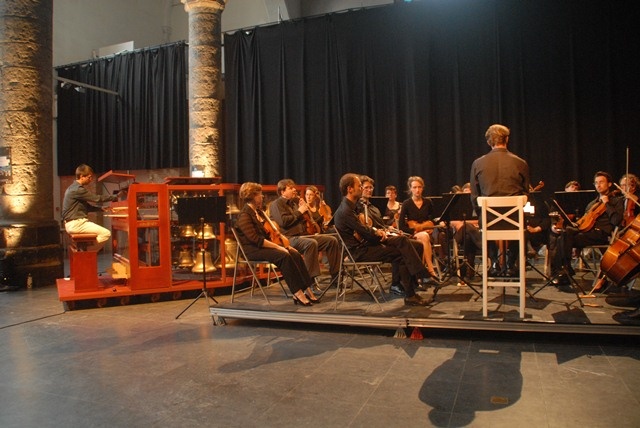 The previous weekend, the Queen Fabiola International Carillon Competition was held at the cultural centre in Mechelen, about 30 km to the north of Brussels. There were going to be Japanese people present as well, so I went to support. This competition began in the year 1988 and is held once every five years. This year is the 7th time. Mechelen has a long history: in the 15th century, for a short period, the city became a capital city of the Low-Countries, which comprised current Belgium and Netherlands. Construction of the Saint Rumbold’s Cathedral in the city centre began in the 13th century, and was planned to reach a height of 167 m, but in 1520 there was danger it might collapse, so the building was left unfinished. Regardless, the current height of 97 m still has sufficient impact. The carillon (set of bells) of the Cathedral consists of 49 individual bells of various sizes that were built in the 17th century, and another set of the same number of bells, which were added in 1981. The bells are known for their beautiful sound that resonates throughout the city. In 1922 a carillon school was built right next to the Cathedral—you could say Mechelen is a ‘carillon town’. It is only natural that the International Carillon Competition, bearing the name of Queen Fabiola, is held in Mechelen, one of the places of origin of the carillon in central Flanders. The previous weekend, the Queen Fabiola International Carillon Competition was held at the cultural centre in Mechelen, about 30 km to the north of Brussels. There were going to be Japanese people present as well, so I went to support. This competition began in the year 1988 and is held once every five years. This year is the 7th time. Mechelen has a long history: in the 15th century, for a short period, the city became a capital city of the Low-Countries, which comprised current Belgium and Netherlands. Construction of the Saint Rumbold’s Cathedral in the city centre began in the 13th century, and was planned to reach a height of 167 m, but in 1520 there was danger it might collapse, so the building was left unfinished. Regardless, the current height of 97 m still has sufficient impact. The carillon (set of bells) of the Cathedral consists of 49 individual bells of various sizes that were built in the 17th century, and another set of the same number of bells, which were added in 1981. The bells are known for their beautiful sound that resonates throughout the city. In 1922 a carillon school was built right next to the Cathedral—you could say Mechelen is a ‘carillon town’. It is only natural that the International Carillon Competition, bearing the name of Queen Fabiola, is held in Mechelen, one of the places of origin of the carillon in central Flanders.
About the guideline for the concert: when I attended the final day, five finalists played two to three solo pieces (free to choose) and one concerto (compulsory) with an orchestra. A movable carillon set-up (49 scales) was brought into the performance hall. It looked just like a set-up for a grand piano concert. The difference with a piano is that it has a hand keyboard of about twenty keys, which you grab and strike with the palms of your hands; as well as a foot keyboard, with about ten keys, which are operated by both feet. For the high notes, the hand keyboard is used (a wire connects the small bells with a hammer), for the low tones, the foot keyboard (large bells). This covers scale of four octaves. In addition, each participant can tune the bells himself to his liking, five to ten minutes in advance. The attire is quite casual (T-shirt and working trousers), which is another contrast to general classical concerts. The Japanese participant I wanted to cheer for, unfortunately, lost in the qualifying rounds and did not remain amongst the five finalists. It was a visit to Mechelen where I only learnt about carillon.
<Japanese Traditional Arts Concert in Co-operation with ISTI>
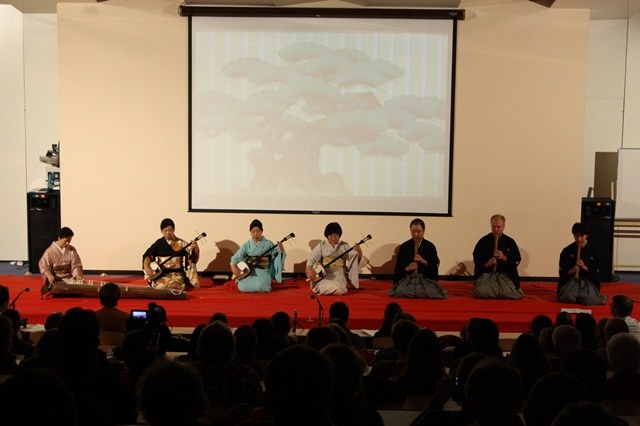 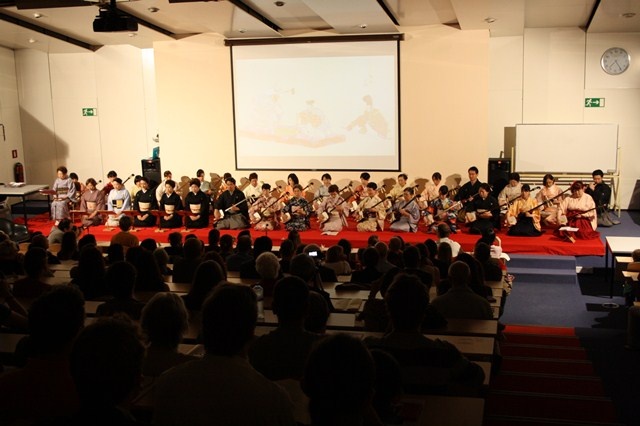 About ten days ago, the Embassy held a Japanese traditional arts concert in co-operation with ISTI, a language school in Brussels, with ‘shamisen’, ‘shakuhachi’ and ‘koto’ musical instruments. The performing artists were a large group of 51 musicians, ‘Pro Musica Nipponia’, who came from Japan and are led by Goshiro Kineya. During their six nights and seven days stay in Brussels, the group also was to perform in Bozar. In between the concert, a satisfying kimono show was also planned. Pro Musica Nipponia has performed all around the world, including in Paris and New York. Surprisingly enough, the group had a performance in Brussels in 1989, 25 years ago. Kineya is a graduate from Tokyo University of the Arts, and whilst being a shamisen player he is also a prominent writer. At the concert several ‘naga-uta’ (meaning: lengthy songs) were played, but even for Japanese it was hard to pick up the lyrics. Therefore I thought it was regrettable that no pamphlets with English lyrics were handed out to the audience to enjoy the songs better. Nevertheless, there are not many occasions to go listen to a Japanese traditional music concert, performed by a big professional group in Brussels, so such a concert as this was really welcome. About ten days ago, the Embassy held a Japanese traditional arts concert in co-operation with ISTI, a language school in Brussels, with ‘shamisen’, ‘shakuhachi’ and ‘koto’ musical instruments. The performing artists were a large group of 51 musicians, ‘Pro Musica Nipponia’, who came from Japan and are led by Goshiro Kineya. During their six nights and seven days stay in Brussels, the group also was to perform in Bozar. In between the concert, a satisfying kimono show was also planned. Pro Musica Nipponia has performed all around the world, including in Paris and New York. Surprisingly enough, the group had a performance in Brussels in 1989, 25 years ago. Kineya is a graduate from Tokyo University of the Arts, and whilst being a shamisen player he is also a prominent writer. At the concert several ‘naga-uta’ (meaning: lengthy songs) were played, but even for Japanese it was hard to pick up the lyrics. Therefore I thought it was regrettable that no pamphlets with English lyrics were handed out to the audience to enjoy the songs better. Nevertheless, there are not many occasions to go listen to a Japanese traditional music concert, performed by a big professional group in Brussels, so such a concert as this was really welcome.
|